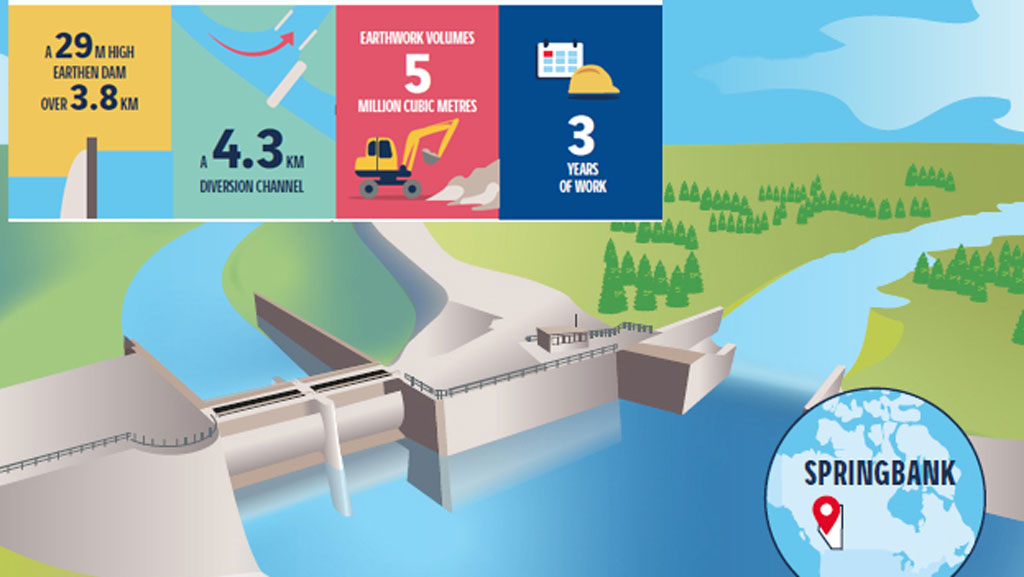A large yellow rock truck backs up at the construction site about 15 kilometres west of Calgary.
A CAT excavator retrieves a bucket load of brown dirt from a pile and shovels it into the back of the waiting vehicle.
Nine years after a catastrophic flood deluged the area in 2013, causing $5 billion in damage, construction work on the $744 million Springbank Off-Stream Reservoir project, known as SR1, has finally begun.
The enormous dry reservoir, one of the largest infrastructure projects ever undertaken in Alberta, will allow water to be diverted from the Elbow River and stored during peak volume events before being released back into the waterway after levels subside. The project is expected to create more than 2,000 jobs.
VINCI Construction, through its earthworks subsidiary specializing in major projects, is building the SR1.
“We are extremely proud and honoured to be awarded the Springbank Off-Stream Reservoir project and to once again collaborate with the Province of Alberta and its communities,” states VINCI CEO Patrick Kadri. “Our teams are highly motivated by the challenges of this major project, creating local jobs and building a sustainable infrastructure which will serve the people of Calgary and surrounding areas.”
Construction work on the project is expected to last for three years. The work includes building a regulation structure on the Elbow River, along with a 29-metre-high earthen dam stretching about 3.8 kilometres.
The dam structure will work together with a water intake and 4.3-kilometre diversion channel. In total, about five million cubic metres of dirt will be moved during the project. As part of the contract, VINCI Construction will also do road development work and build large engineering structures on adjacent roads.
According to VINCI, the contract acknowledges the company’s expertise in infrastructure that contributes to climate resilience in support of sustainable development. VINCI has more than 115,000 employees worldwide and more than 5,200 in Canada.
SR1 covers 3,700 acres in a floodplain drainage area of the Elbow River and its tributaries. The aim of the project is to manage downstream river flow rates and volume and protect Calgary and other downstream communities along the Bow and Elbow rivers from a once-in-a-century event as part of an overall flood mitigation system. SR1 has been designed to work in tandem with the Glenmore Reservoir in Calgary.
The reservoir is being constructed in agricultural area and wetlands. The Government of Alberta has acquired all of the land required to build SR1 and the province is footing $576 million of the project bill.
The project was delayed due to opposition from some Springbank landowners and the Stoney Nakoda First Nation, who were in favour of another location for the reservoir further upstream. However, the province worked with the First Nation and the community is now on board. All the land needed for the project was acquired voluntarily, and there was no need for expropriations.
“The Stoney Nakoda Nations are pleased to participate in the SR1 project and we are hopeful that this project will provide a level of protection to Calgary and our many friends downstream from future flooding,” said Chief Clifford Poucette of Wesley First Nation, one of three Nakoda tribes in the area.
Chief Aaron Young of Chiniki First Nation, another of the Nakoda tribes, said the project will provide economic opportunities for local residents who will help build the reservoir.
Transportation Minister Rajan Sawhney said the 2013 flood and aftermath from destruction were devastating.
“It is very painful for many Albertans when they cast their memory back to that time. Many people’s homes and businesses were significantly damaged, some beyond repair.”
Until the 2016 fire in Fort McMurray, the 2013 flood was the costliest in Canadian history. More than 30 communities declared local states of emergency and more than 125,000 people were evacuated.
“With work now underway, Calgary and surrounding communities can rest assured that SR1 will protect our communities against a future one-in-a-100 year flood,” said Sawhney. “I know many people, including myself, are pleased to see construction finally begin.”
Federal Intergovernmental Affairs, Infrastructure and Communities Minister Dominic LeBlanc said residents of southern Alberta have experienced first-hand the repercussions of climate change.
“Once completed, the Springbank Off-Stream Reservoir will protect the livelihoods of thousands of people by significantly increasing the region’s resiliency to floods and natural disasters.”
Calgary Mayor Jyoti Gondek said moving the flood mitigation project forward to construction is welcome news.
“Strengthening critical infrastructure like this will help reduce our vulnerability to a changing climate and extreme weather events, preventing future widespread damage,” he said. “Combined with the city’s efforts to date, Calgary’s overall flood risk will be reduced by approximately 70 per cent from 2013.”











Recent Comments
comments for this post are closed